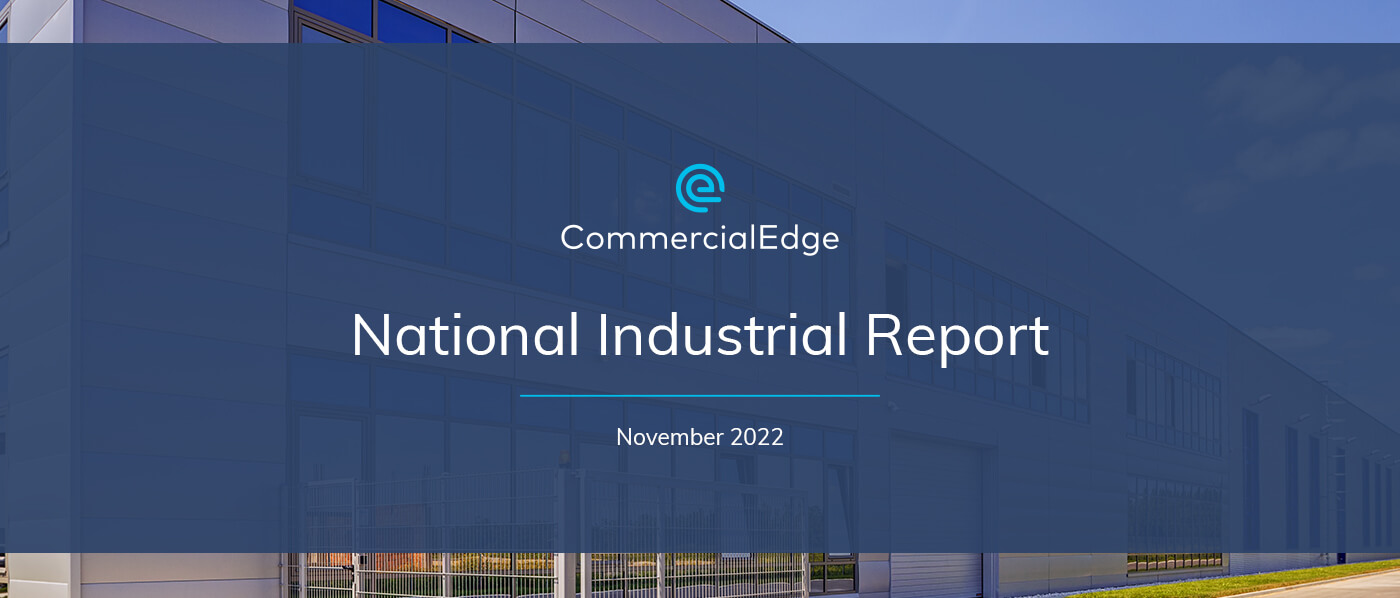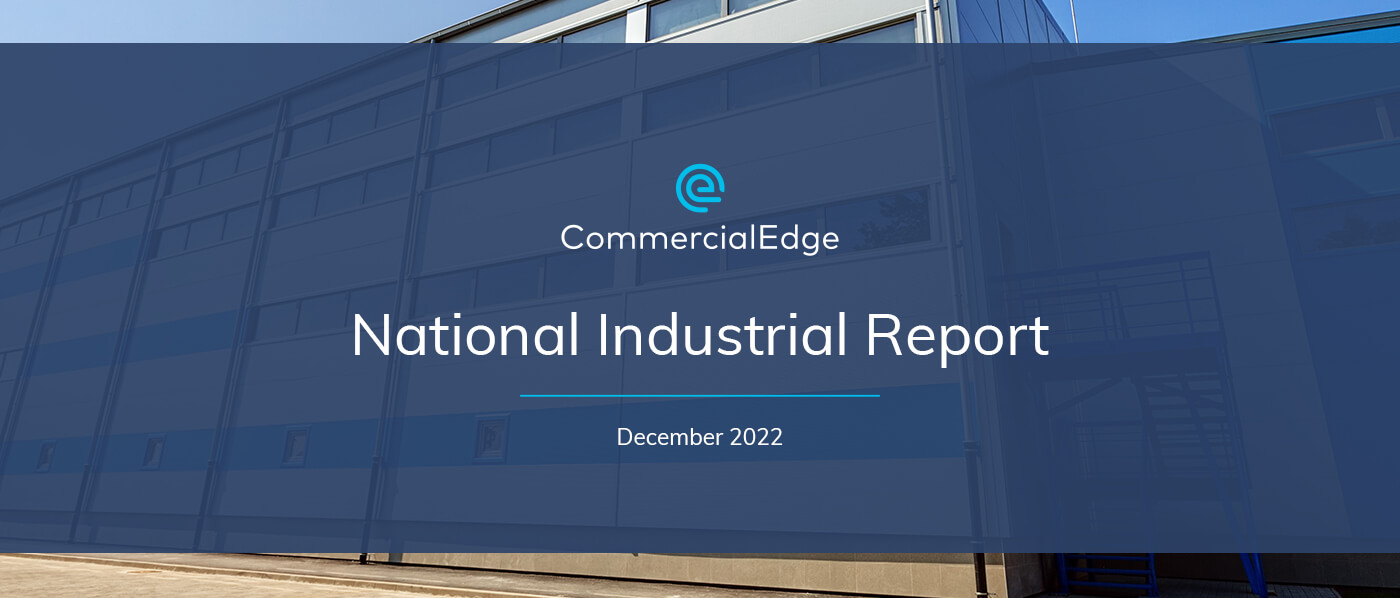Key takeaways:
- National industrial in-place rents averaged $6.95 per square foot, up 5.8% over year-ago figures as demand remains strong
- The national vacancy rate contracted 10 basis points compared to the previous month as new deliveries were absorbed at a rapid pace
- Nearly 714 million square feet of industrial space was under construction at the end of October, despite Amazon’s pullback from its aggressive expansion policy
- The national price per square foot remained unchanged month-over-month, while the year-to-date sales volume increased by $6.5 billion
- The Western U.S. claimed the six most expensive markets in terms of sales prices
- Increasing interest in Detroit results in the sharpest rent growth in the Midwest at 6.2%
- Dallas’ market expansion showed no signs of slowing, with local development pipeline nearing 67 million square feet
- The New Jersey sales volume remained strong in Q3, nearing $3 billion year-to-date
The new development pipeline continued to expand in the third quarter despite the headwinds of increasing financing costs and general economic uncertainty, signaling that demand for space continues to outstrip the pace of new deliveries. There were 713.6 million square feet of industrial space under construction at the end of October, representing 4.0% of stock.
Additionally, nearly 350 million square feet have already been delivered this year, reaching historic levels. Despite this, the national vacancy rate stood at 4% in October, following a steadily decreasing trend throughout the year.
The construction pipeline volume is tremendous, however, with vacancy rates still hovering around 4% nationally, there continues to be an appetite for that space to be delivered. It does seem likely the rate of construction backs off this current record pace getting into 2023 though.
Peter Kolaczynski, Operations Senior Manager
Rents and Occupancy: Port Markets Continue to Lead the Pack
Industrial rents have continued to grow in the country’s top markets throughout the year, with the national in-place rents for industrial space averaging $6.95 per square foot in October. That represented a 5.8% year-over-year increase and a seven-cent uptick over September figures.
Port markets continued to lead the country both in terms of in-place rent growth, as well as new leases. As has been the case over the past two years, in-place rents have grown at the sharpest rate in Southern California, led by the Inland Empire’s double-digit price increase. On the Eastern seaboard, Boston and New Jersey experienced robust rent growth and demand here is expected to increase further.
Average Rent by Metro
Premiums paid by tenants for new leases also continued to grow over the last year: new contracts now cost $1.54 more per square foot than the national average for all leases. The largest spreads were, of course, in already costly port markets with little space for further expansion: Los Angeles, the Inland Empire, Orange County, and New Jersey.
The national vacancy rate stood at 4.0% in October, which marked a decrease of 10 basis points from the previous month. Vacancy rates generally remained lowest in port markets as well, but non-port markets with a heavy logistics presence also continued to contend with low levels of available space. Among those, Atlanta, Nashville, Indianapolis, Columbus, and Kansas City had vacancy rates lower than 3%.
Supply: Industrial Starts Continue at Robust Pace, Despite Amazon Pullback
A total of 713.6 million square feet of industrial space was under construction at the end of October, representing 4.0% of the existing national stock. Projects currently in the planning stages are expected to add a nearly equal amount of space. Shipping, logistics and chip manufacturing are driving much of the industrial space construction throughout the U.S.
In 2021, seven Amazon distribution centers larger than two million square feet started construction across the country. But earlier this year the company admitted that their expansion had been overzealous, and only broke ground on three projects. Despite the retail giant’s pullback, shipping and logistics account for half of the 20 largest industrial projects under construction.
Industrial Space Under Construction (Million Sq. Ft)
The vital semiconductor sector is also a notable driver of industrial space development, especially in terms of manufacturing space, with a significant boost from recent legislative efforts to reshore production of key industries. This sector is also represented in some of the country’s 20 largest industrial projects currently under way.
Transactions: Southern California Sale Prices Still Outpace Rest of the Country by Wide Margins
Nationally, there were $71.9 billion in industrial sales recorded during the first 10 months of the year. Although the sales volume for the first two quarters of this year was ahead of 2021 — a record-setting year itself — sales slowed in the second half of this year. With the Federal Reserve hiking the rates by 75 basis points multiple times, the transactions market has cooled as capital gets more expensive and deals become tougher to pencil out. However, in spite of increasing rates and general economic uncertainty, investors are still looking to buy well positioned assets.
Year-to-Date Sales (Millions)
Los Angeles, the Inland Empire and Dallas all closed more than $4 billion in industrial deals year-to-date, totaling nearly $17 billion across the three leading industrial markets in terms of transactional activity.
In terms of price per square foot, however, Southern California still leads, with year-to-date sales prices even surpassing $350 per square foot in its hottest market.
Year-to-Date Sale Price Per Square Foot
Western Markets: Region is Home to Six of the Top 10 Priciest U.S. Markets
With Southern California’s tight vacancies, high lease prices and robust rent growth, the industrial sector has been consistently outperforming all other industrial markets. Orange County’s year-to-date price rested at $360 per square foot, followed by the Inland Empire at $301 per square foot, and Los Angeles close behind at $297 per square foot. Los Angeles and the Inland Empire also had the largest sales volumes year-to-date — $4.37 billion and $4.06 billion, respectively.
But transactional activity has been significantly more muted in Orange County, where industrial sales amounted to $1 billion so far this year, placing the OC between the sales totals of Columbus and Indianapolis. In fact, while the West was home to some of the largest sales volume markets in the country, it was also home to two of the quietest markets in terms of transactions. Specifically, the Central Valley and Portland closed only $549 million and $527 million, respectively, in industrial deals year-to-date.
The Bay Area and Seattle stood between the two extremes in terms of sales volume but had the next-highest prices per square foot at $236 and $235, respectively. Moreover, Phoenix was the only other market to surpass the $200 per square foot sales price threshold nationwide, meaning that the country’s six most expensive markets in terms of sales prices are currently all located in the West.
Furthermore, the sharpest rent increases were also here: In fact, the Inland Empire was the only market where rent-growth reached into double-digit category, with local rates shooting up 11.6% over the past 12 months. Los Angeles was close behind though, with October leases inked at rates 9.7% over year-ago figures.
West Regional Highlights
Although the next-sharpest rate increase took place in Boston, the following two were Western markets again with both Orange County and Phoenix lease rates growing 7.6% year-over-year. Rent growth in Phoenix has been driven by the market taking on spillover demand from the Ports of Los Angeles and Long Beach that Southern California cannot handle. And while new leases averaged $1.54 more per square foot nationally than in-place leases, the largest spreads were in Los Angeles ($6.10 more per square foot), the Inland Empire ($5.60) and Orange County ($4.17).
In terms of vacancies, the Inland Empire remained the tightest market as has been the case for several quarters now, closing October with a mere 1% vacancy rate. The Central Valley, Los Angeles and Phoenix posted vacancies between 2% and 3%, with all other markets remaining less than 6.5% vacant.
Phoenix, of course, still had the largest supply pipeline on a stock basis and the second largest in terms of square footage, as it continues to attract those squeezed out of Southern California. To be precise, Phoenix closed October with 46.6 million square feet of industrial space under construction that will increase its existing industrial square footage by 15.6%, with another 18.3% in the planning stages.
At the same time, the Inland Empire had the fifth-largest construction pipeline on a percentage-of-stock basis, currently developing the equivalent of 5.6% of its existing stock: 34.5 million square feet. When also counting planned developments, the country’s tightest industrial market may add a total of 9.9% of its existing stock. Conversely, Portland and Los Angeles had some of the most modest construction pipelines among the country’s leading markets: just 0.8% and 0.7% of their respective stocks.
Midwestern Markets: Detroit Leads Regional Rent Growth
In the Midwest, markets with heavy logistics presences and no geographic or zoning constraints for development are adding space at a rapid pace. In fact, Indianapolis and Columbus have the third and fourth largest construction pipelines, with the equivalent of 7.4% and 5.9% of their respective stocks currently being developed.
These efforts will add 24 million square feet of space to the Indianapolis industrial market and 16.7 million square feet in Columbus. When taking into account planned projects as well, Indianapolis is looking at an increase of 12.6% of its current square footage, while stock in Columbus might increase by 9.1%. At the same time, when projects currently under construction are delivered and if all planned developments materialize, Kansas City could increase its industrial footprint by an impressive 18.6%.
Developments in these Midwest markets are driven by some of the lowest vacancy rates in the country. Specifically, vacancy rates stood at 2.7% in Kansas City, 2.5% in Indianapolis and 1.6% in Columbus.
Midwest Regional Highlights
But, unlike port markets where space is tight for new projects, all three Midwestern markets maintained rent growth at no more than 3.4% over the past 12 months, with Kansas City increasing rates by just 2.7% year-over-year. In fact, leases signed in Kansas City over the past 12 months averaged $3.95 per square foot, lower than the $4.55 per square foot average for in-place contracts.
Notably, the sharpest rent growth in the Midwest was claimed by Detroit, where October rents were up 6.2% year-over-year, making Detroit the second-priciest market for industrial leases in the Midwest at $6.15 per square foot. As a result, it outpaced Chicago, which recorded a rent rate of $5.59 per square foot.
As for transactional activity, the only market to surpass $1 billion in industrial sales year-to-date was Columbus at $1.02 billion. However, Indianapolis might also soon surpass that threshold, totaling $993 million so far this year. At $850 million, Detroit had the region’s third largest sales volume year-to-date. The Midwest also contended with the South for some of the lowest prices per square foot, as only the Twin Cities surpassed $100 per square foot, while Detroit assets traded for an average of $66 per square foot.
Southern Markets: Dallas Further Increases Construction Pipeline to Nearly 67 Million Square Feet
Similarly to logistics hubs in the Midwest, markets in the South with a large logistics sector are also contending with low vacancy rates. Among those are Nashville and Atlanta, which saw vacancy rates of 1.4% and 2.3% respectively. But the South was also the setting for some of the highest industrial vacancies in the U.S., with Houston closing October at 7.6% vacancy.
Despite this, Houston has 25 million square feet of new industrial space under construction, which will increase its existing stock by 4.5%. Furthermore, if all planned projects materialize, the city may see an increase in industrial space of 7.6%.
But Houston isn’t the only industrial market in the South pushing for significant space expansions, as many of the markets in the region do not have to contend with the space constraints that port markets, for example, have to face. Although Charlotte’s 15.5 million square-foot construction pipeline represents a smaller footprint than that of Atlanta, on a percentage-of-stock basis, it represents a 5.3% increase for Charlotte’s industrial stock.
Of course, the South’s — and the country’s — largest development pipeline in terms of square footage remains the expansion of the Dallas – Fort Worth market. Last month, the Dallas market had 62 million square feet of industrial space under construction, which has since further increased to reach 66.7 million square feet. While the market’s current construction pipeline is set to boost its industrial footprint by 7.8%, stock planned for the market that has yet to break ground could bring that increase as high as 13.1%.
South Regional Highlights
Despite this vast new supply pipeline, Dallas – Fort Worth tied with Miami for the South’s sharpest rent growth at 6% year-over-year. For the Dallas market that meant an average rent of $5.15 per square foot, with leases signed over the past 12 months averaging $6.12 per square foot. In Miami though, that 6% year-over-year increase resulted in the region’s widest lease spread at $2.33 per square foot. Specifically, the average industrial rent in Miami stood at $9.57 per square foot in October — the South’s priciest — while leases signed in the past year averaged $11.90 per square foot.
As for sales prices, Nashville led the region at a rate of $152 per square foot year-to-date, followed by Tampa with a rate of $128 per square foot and Atlanta with $117 per square foot. On the other end of the spectrum stood Memphis, which sported the lowest year-to-date sale price among the country’s leading industrial markets — $60 per square foot.
And while Dallas stood approximately midway between the region’s lowest and highest price per square foot, it remained the region’s leader in terms of sales volume. In fact, its $4.05 billion year-to-date sales volume was the third largest in the country. Houston was next with $3.69 billion in industrial sales, followed by Atlanta, where sales totaled $1.82 billion.
Northeastern Markets: Smaller Sales Drive New Jersey Volume
As port markets continued to log the sharpest rent increases in the country, Boston’s rents have grown 8.9% and the New Jersey market has seen 7.2% growth, resulting in average rates of $9.03 per square foot in both markets. New Jersey is especially primed for further rent growth as new lease premiums here reached $3.32 per square foot.
Moreover, demand is expected to increase even further especially as the Port of New York and New Jersey became this busiest in the nation by number of containers handled. This shift is expected to further fuel demand for industrial space in the region, not only in New Jersey, but also spilling out into the markets of Allentown-Bethlehem and Scranton-Wilkes-Barre.
Northeast Regional Highlights
New Jersey was also one of the few markets where total sales volume did not fall year-over-year in the third quarter. Unlike other markets with comparable volume, New Jersey is not boosted by massive transaction figures from a few properties, but rather has seen numerous sales of smaller properties. The median sale price in the market is $10.1 million over more than 150 transactions.
New Jersey’s sales volume thus reached $2.87 billion year-to-date — the seventh highest in the country — but its $176 per square foot year-to-date sales price could not contend with the West’s more vertical pricing. At $180 per square foot, Boston’s year-to-date sale price was the highest in the Northeast. However, Boston’s $1.7 billion sales volume was outpaced by Philadelphia’s $2.53 billion, which it reached with an average $124 price per square foot.
Philadelphia also stood out in terms of new supply, with 16.7 million square feet of industrial space under construction at the end of October, which will increase its existing footprint by 4.1%. As a result, Philadelphia had the largest development pipeline in the Northeast, followed by New Jersey with 13 million square feet. Boston and Baltimore had less than half of that, totaling 6.1 million square feet and 5.3 million square feet under construction, respectively.
Economic Indicators: Warehousing Employment Falls in Second Half of Year
A pandemic-driven boom in e-commerce spending caused employment in the warehousing and storage sector of the labor market to surge for two years. However, since this summer, the number of jobs in the sector has fallen, with October being the fourth consecutive month of job losses. There were 20,000 fewer warehousing and storage jobs in October than in September, marking a monthly decline of 1.1%. The sector has lost 49,000 jobs since June, a rapid turnaround after growing at least 9% year-over-year during the previous 24 months.
Economic Indicators
Amazon — by far the largest employer in the warehousing and storage sector — has abandoned or delayed the opening of multiple distributions facilities across the country, and admitted in earnings calls earlier this year that it hired too many fulfillment center workers in 2021. The high turnover rate of workers in Amazon warehouses, reported to be around 100% per year, means that a hiring slowdown by the company could be causing the drop in the sector, simply through attrition of their workforce.
Warehousing and Storage Employment
Trends & Industry News: Cautious Optimism as Year Winds Down
In the face of rising interest rates leading to more volatile capital markets, flattening e-commerce sales growth, and Amazon pausing the rapid expansion that dominated the sector in recent years, the industrial sector remains on solid footing as we head into 2023.
The largest logistics providers in the nation paint a picture of cautious optimism for the logistics sector in recent earnings calls and research reports. Link Logistics, the logistics arm of Blackstone, is seeing “healthy, broad-based demand” and said that during the third quarter its same-store portfolio was 97.4% leased. Despite economic uncertainty, Link indicated that its real time data and insights from their platform provide “conviction in the favorable outlook for the logistics sector.”
Prologis’s Industrial Business Indicator research report forecasts that the frantic pace of logistics leases will normalize in coming months. Although Prologis stated in their recent earnings call that they will slow speculative projects and favor developments with committed tenants, deliveries for the industrial sector will remain historically elevated at least through 2024. For a sector that has run hot for more than two years now, increased deliveries combined with the “slightly lower net absorption” in logistics forecasted by Prologis Research could bring more sustainable growth to industrial real estate.
National New Supply Forecast (Square Feet)
CommercialEdge expects that demand for industrial space will remain strong in coming years, although it is unlikely that the torrid pace at which the sector grew during the pandemic will be seen again. While the rapid growth of e-commerce and logistics may taper off, the slack could be picked up by reshored manufacturing.
Numerous semiconductor plants were underway when 2022 began, and the passage of the CHIPS and Science Act, which includes billions in incentives for chip manufacturing, will stimulate further investment in semiconductors. Because they are a critical component in the production of countless goods — from washing machines and automobiles to smartphones and medical equipment — expanded chip manufacturing is a vital first step in a reshoring movement.
Download the complete November 2022 report for a full picture of how U.S. industrial markets fared in the first eight months of the year, including insights on industry and economic recovery fundamentals.

You can also see our previous industrial reports.
Methodology
The monthly CommercialEdge national industrial real estate report considers data recorded throughout the course of 12 months and tracks top U.S. industrial markets with a focus on average rents; vacancies (including subleases but excluding owner-occupied properties); deals closed; pipeline yield; forecasts; and the economic indicators most relevant to the performance of the industrial sector. For a detailed methodology, download the full report using the link provided above.
Stay current with the latest market reports and CRE news:
Latest Posts
Recent Reports
Despite Record New Supply, National Industrial Vacancy Dips Below 4%
More than 742 million square feet of industrial space was under construction at the end of November as demand continues to outstrip supply.
Tech Sector Downsize Further Challenges Office Recovery
The average listing rate for office space stood at $38.06 in November, while vacancies rested at 16.2% across the top 50 U.S. office markets.
Office Vacancy Rates Continue to Climb Across the Country in 2022
The average listing rate for office space stood at $37.94 in October, while vacancies rested at 16.3% across the top 50 U.S. office markets.





